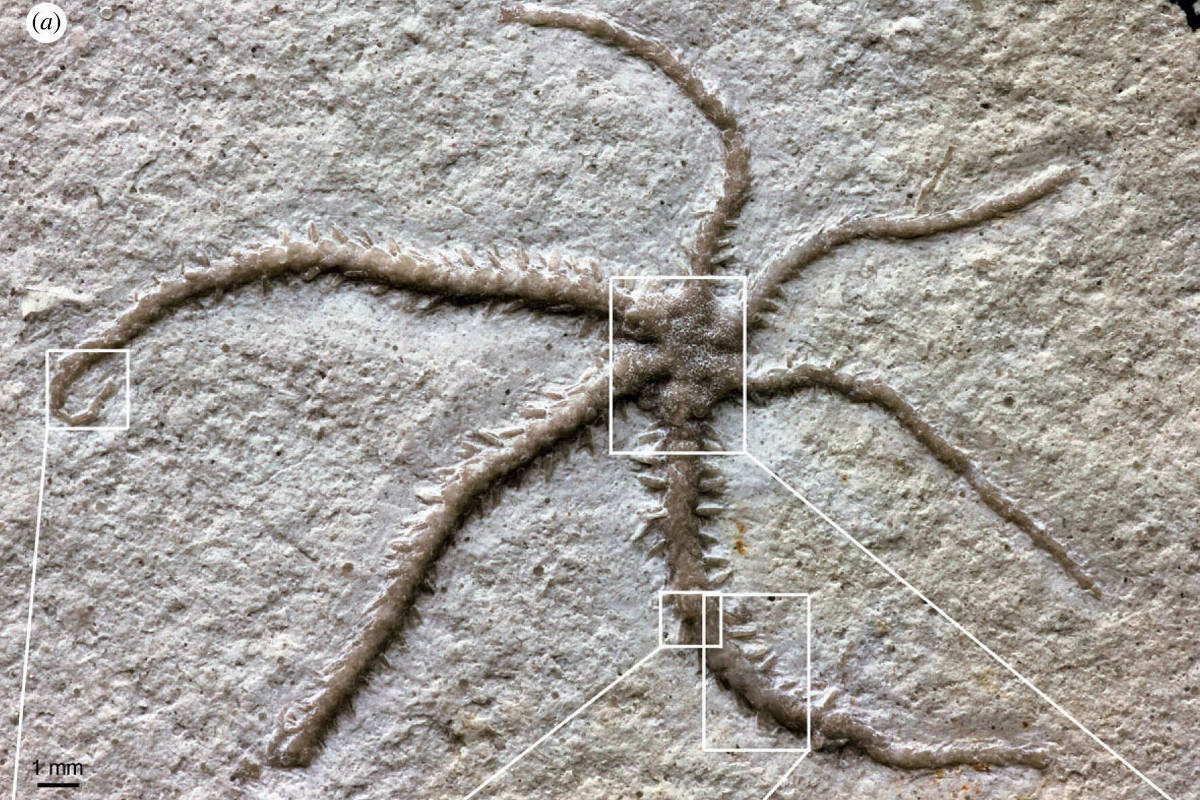Some ophioroids provide an arm and a leg (and another appendage) for reproduction. When mates are scarce, these starfish-like marine creatures split in half. Each side then replenishes the missing half, creating two identical copies of the original animal.
This process, known as clonal fractionation, is practiced by approximately 50 extant species of ophioroids and their starfish relatives. However, scientists have found it difficult to pinpoint when ophiuroids, a clumsy group of echinoderms, began to reproduce in this way.
A fossil recently discovered in Germany pushes the origin of starfish cloning to more than 150 million years ago. In an article published on Wednesday in Journal of Proceedings of the Royal Society Ba team of scientists describes the fossil of an ophioroid that fossilized while regenerating three of its six limbs.
“It is the first fossil evidence of this phenomenon,” said Bin Thuy, a paleontologist at the National Museum of Natural History in Luxembourg and author of the new study. He added that the sample shows that “clonal fragmentation is actually much older than previously thought.”
An ophioroid fossil was discovered in limestone deposits at Nussblingen in southern Germany. At the end of the Jurassic period, 155 million years ago, this area was a temperate lake home to marine crocodiles, sharks and pterosaurs. When some of these creatures died, they sank to the bottom and were buried in mud. Low oxygen levels slowed their decomposition, preventing predators from feeding on the carcasses.
These conditions have preserved the fossils in incredible detail, capturing delicate structures such as dragonfly wings and even a dinosaur feather. The newly described ophioroid is another treasure imprinted in the site’s limestone slabs. “You have this ophioid with each piece in its original place, as if the tide washed it ashore yesterday,” Thuy said.
The ophioroid fossil was discovered during excavations conducted by researchers at the State Museum of Natural History in Stuttgart, Germany, in 2018. Thuy joined researchers from across Germany and Austria to study the fossil.
The asymmetrical anatomy of the ophioids attracted attention. Three of its arms were thin-featured compared to the other three, which were larger and dotted with spikes.
Scientists placed the ophioroid inside a CT scanner to examine its structure. They also compared the animal’s anatomy with that of other ophioid species.
The researchers concluded that the fossil is the oldest known member of the still-existing ophioroid family called Ophiactidae. They placed the ophioroid fossil in the genus Ophiactis and added the species name Hex, in reference to its six arms, and as a tribute to Hex, a magical supercomputer created by fantasy writer Terry Pratchett. In Pratchett’s “Discworld” books, Hex can imagine the unimaginable.
For scientists, discovering a fossilized creature that cloned itself was unthinkable.
In the past, researchers have discovered fossil sea stars that regenerate their individual limbs. A brittle star from Jurassic deposits in Switzerland even regenerated several limbs as it fossilized. But the irregular growth patterns in these earlier fossils appear to represent sea stars regaining limbs lost due to injury. in contrast, Oh fortune teller It appears to regenerate limbs along a symmetrical plane, making it the only known echinoderm fossil frozen in the wake of cloning.
The new fossil provides evidence that brittle stars have split in two since at least the late Jurassic. According to Gordon Hendler, curator of echinoderms at the Natural History Museum of Los Angeles County, approximately half of all living Ophiactis brittle stars are capable of splitting into two. Asexual reproduction helps slender scavengers quickly colonize environments such as spongy meadows and moss patches.
Since they generally live in densely populated groups, it may be possible to find more fragile star clones in the Nussblingen limestone. But Hendler says a fossil like this specimen has been found Oh fortune teller It was a matter of luck.
“The chances of discovering another such ancient link appear to be very slim,” he said in an email. “I hope I’m wrong!”

“Hardcore beer fanatic. Falls down a lot. Professional coffee fan. Music ninja.”







More Stories
Science shows the impact of video games on mental health
The Museum of Tomorrow and SESI Laboratory present the “Experience with Science” exhibition
Adherence to the first day of dengue vaccination in Santa Cruz is low